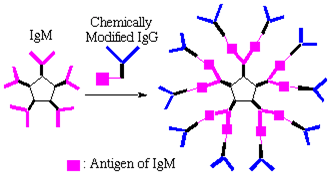 |
|
|
|
Supramolecular Assembly of Bio-Related Polymers and Their Functionalization |
Antibody Dendrimer
"Antibody Dendrimer"

In a complete departure from traditional approaches, Harada used immunoglobin M (IgM) as a core and chemically modified IgGs as branches in a divergent growth strategy which resulted in novel, highly branched antibody based supramolecules with molecular weights of over 2 000 000. Even though these structures were held together by non-covalent bonds, their dendritic nature permitted the binding of antigens with high specificity. These antibody-based dendrimers show great promise for high sensitivity detection of a wide range of chemicals and biomolecules
Reported by C. J. Hawker et al. in J. Mater. Chem., 2003, 13, 2653-2660.
- Construction of Redox-Induced Systems Using Antigen-Combining Sites of Antibodies and Functionalization of Antibody Supramolecules Yamaguchi, H.; Harada, A. In Redox Systems under Nano-Space Control, Hirao, T. Ed. Springer, Heidelberg, 2006, 263-291.
- Antibody Dendrimers, Yamaguchi, H.; Harada, A. Top. Curr. Chem., 2003, 228, 237-258.
- Dendritic Antibody Supramolecules, Combination of IgM and IgG Harada, A.; Yamaguchi, H.; Tsubouchi, K.; Horita, E. Chem. Lett., 2003, 32, 18-19.